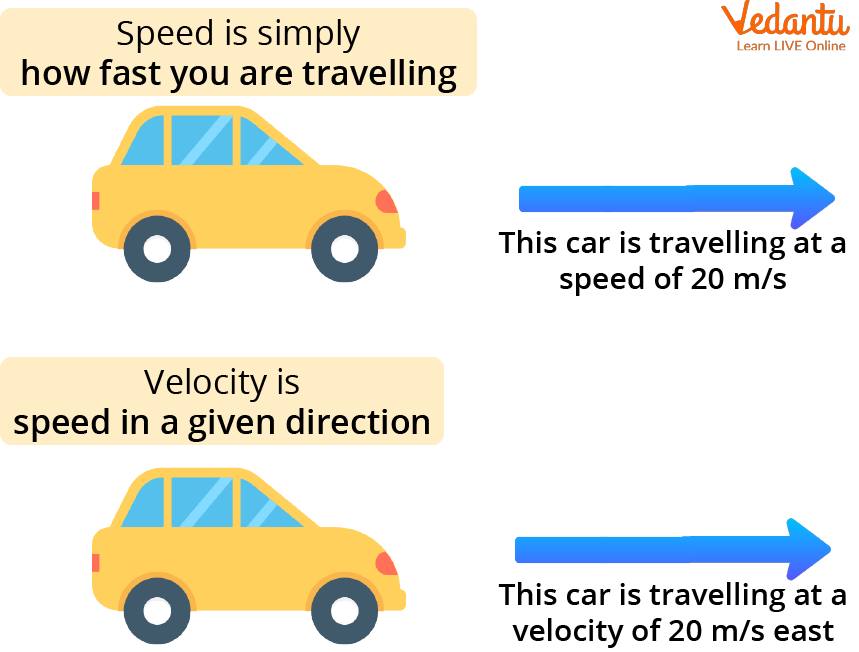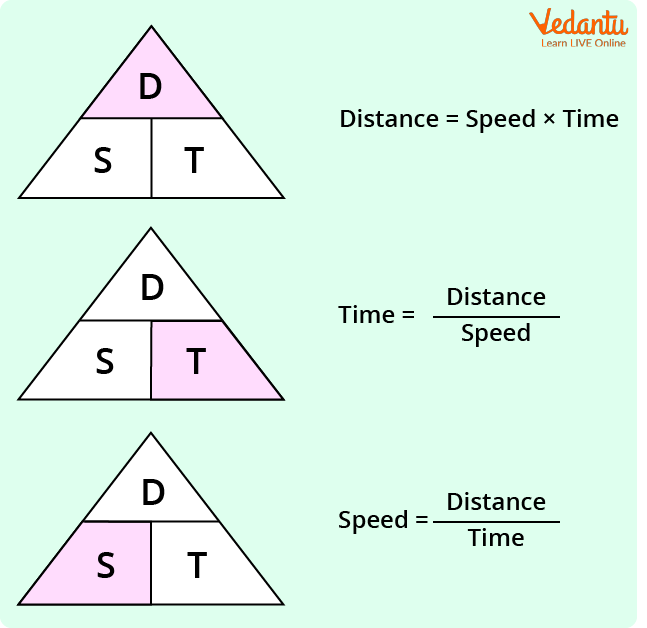




How Is Speed Measured and Why Is It Important?
We have all heard the term ‘speed’ on different occasions in different contexts and know various definitions of it. But do you know what the meaning of speed really is? Like sometimes our teachers ask us to speed up in writing homework or eating food. What do they actually want us to do? They want us to finish that work early by doing it fastly. This daily vocabulary word “speed” has an individual definition and a meaning itself. All of us have a little idea of what speed may be but let’s learn it in terms of Science!
Definition of Speed
Speed definition can be given as a measurement of the distance covered by an object with respect to the time it takes to cover that distance. In simpler words, it is a measurement of how fast an object moves, but it does not give direction. If we get direction with speed, then it is called “velocity”.

Speed and Velocity
Measurement of Speed
In Science, speed can be calculated. The speed formula is a science-derived formula and is used for calculating various kinds of speed. The speed formula is:
$\mathrm{Speed}=\dfrac{\text{Distance}}{\text{Time}}$
Unit of Speed
Unit of speed is most commonly expressed using the SI unit system. According to that system, speed is measured in metres/second or m/s as the distance is in metres and time in seconds.
Representation of unit: The speed is measured in metres per second (ms-1) and denoted by “s”.
The distance travelled is measured in metres (m) and denoted by d.
“t” is the amount of time spent and measured in seconds (s).
The speed formula consists of three elements: distance, time, and speed. By using this single formula, two more formulas can be derived like this:

Formulas of Speed
Average Speed
The overall distance travelled by the object in a given time frame is the average speed. Average speed is a scalar quantity. Scalar quantity means it has no direction and is indicated by the magnitude.
Formula for Average Speed
Calculating the total distance travelled by the body to the time taken to cover that distance yields the average speed formula.

Average Speed
The following is the representation of the average speed formula:
$\mathrm {S_{avg}}=\dfrac{\text{Total Distance Covered D}}{\text{Total Time Taken T}}$
Where Savg is for average speed,
D is for total distance covered, and
T is for the total time taken.
Interesting Facts About Speed
Galileo was the first scientist to measure speed as a function of distance over time.
An instrument to measure immediate speed is a speedometer.
186,282 miles per second is another way to write the speed of light.
In dry air, the speed of sound is 343.2 meters per second.
Summary
The distance that an object travels in relation to the amount of time it takes to do so can be used to define speed. It is a measurement of how quickly a thing moves, to put it another way. As the distance is in metres and the time is in seconds, speed is expressed in metres per second or m/s.
The average speed of an object is the total distance it travels in a predetermined amount of time. The average speed is a scalar quantity. The magnitude of a scalar quantity, which has no direction, is used to describe it.
FAQs on What Is Speed? Definition, Units & Everyday Examples
1. What is speed in Science and what is its SI unit?
In science, speed is defined as the rate at which an object covers a distance. It measures 'how fast' an object is moving, without considering its direction. Because it only has magnitude and no direction, it is a scalar quantity. The standard international (SI) unit for speed is metres per second (m/s). Other common units include kilometres per hour (km/h) and miles per hour (mph).
2. How do you calculate speed using its formula?
You can calculate the speed of an object by dividing the total distance it has travelled by the total time taken to cover that distance. The formula is:
Speed = Total Distance Covered / Total Time Taken
For example, if a car travels 150 kilometres in 3 hours, its average speed is calculated as 150 km / 3 hours = 50 km/h.
3. What are the main types of speed? Explain with examples.
There are four primary types of speed:
Uniform Speed: An object has uniform speed if it covers equal distances in equal intervals of time. For example, a train moving at a constant 80 km/h on a straight track.
Non-uniform or Variable Speed: An object has non-uniform speed if it covers unequal distances in equal intervals of time. For instance, a person jogging in a crowded park.
Average Speed: This is the total distance covered by an object divided by the total time taken. It is used to describe the overall speed of a journey where the speed was not constant.
Instantaneous Speed: This is the speed of an object at a particular moment or instant in time. The speedometer in a car shows the instantaneous speed.
4. How is speed fundamentally different from velocity?
The fundamental difference between speed and velocity lies in the concept of direction.
- Nature: Speed is a scalar quantity, meaning it only describes magnitude (how fast). Velocity is a vector quantity, describing both magnitude and direction (how fast and in which way).
- Direction: Speed does not have a direction associated with it. Velocity always includes a specific direction.
- Example: A car's speed might be 60 km/h. Its velocity would be 60 km/h east.
5. Why is speed always considered a positive value while velocity can be negative?
Speed is calculated from distance, which is the total path length covered and can never be negative. Therefore, speed is always a positive value or zero. Velocity, however, is calculated from displacement, which is the change in position and has a direction. If we define a forward direction as positive, then movement in the opposite direction is considered negative. Thus, velocity can be positive, negative, or zero, depending on the direction of motion relative to a reference point.
6. Can an object have a constant speed but a changing velocity? Explain how.
Yes, an object can have a constant speed while its velocity is continuously changing. This occurs when the object changes its direction of motion. The best example is uniform circular motion, such as a satellite orbiting the Earth at a constant speed. Although its speed (the magnitude) is constant, its direction is changing at every point along its circular path. Since velocity depends on both magnitude and direction, a change in direction results in a change in velocity, even if the speed remains the same.
7. What does it mean for a car's motion to be described by non-uniform speed?
When a car's motion is described as having non-uniform speed (or variable speed), it means the car is covering unequal distances in equal intervals of time. In simple terms, the car is either speeding up or slowing down. A real-world example is a car travelling through city traffic; it starts, stops at traffic lights, speeds up on clear roads, and slows down for turns, making its speed constantly change.









